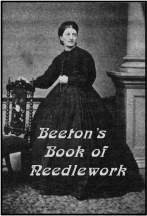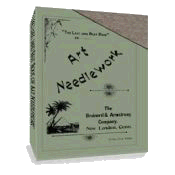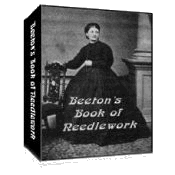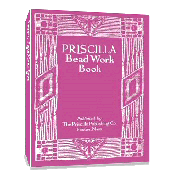Redwork

Plus
Free Beeton's Book Of Needlework, 433 pages!
|
Redwork became popular following the 1876 Centennial Exposition in Philadelphia, Pennsylvania. An exhibit by the Kensington Royal School of Art Needlework featured this new type of needlecraft. Its popularity grew rapidly. Soon all sorts of household items could be found decorated with this type of embroidery.
The fascination with this type of embroider was due to a number of reasons.
- The red thread used was colorfast. Until this time, only silk thread was colorfast and the cost of the silk thread made decorating items used daily cost prohibitive. Items used daily and washed often were usually decorated white on white. With this new colorfast floss, color could be introduced on even the most mundane of items.
- Low cost.Since this thread was cotton, its cost made it affordable to all embroiderers, not just the wealthy. Also, because of the simple stitches used, less thread was needed than that of traditional embroidery, whitework or blackwork.
- Its simplicity and availability. Since the subject matter was usually very simple drawings, no special embroidery stitches or techniques were needed. This allowed even the less knowledgeable embroiderer to produce very nice pieces of needlework. Since the materials could be found in almost any store, anyone wishing to try their hand at Redwork could easily find the materials needed.
| Tea towels | Dish towels | Table and luncheon cloths |
| Pillow shams | Aprons | Embroidered tidies |
| Antimacassars | Splashers | Napkins |
| Dresser scarves | Chair cushions | Sofa pillows |
Often a child's first attempt at embroidery was Redwork using "Penny Squares." Penny Squares usually measured 6 x 6 inches, were made of muslin and had printed designs on them. They were available at almost any drygoods or general store and sold for a penny. Today you may see these Penny Squares in quilts of that era.
Penny Square designs included:
| Children | Children's nursery rhymes | Storybook characters |
| Historical figures | Famous buildings | Household items |
| Flowers | Fruits and vegetables | Animals |
| Japanese inspired designs | ||
Redwork became so popular that newspapers and publications such as Work Basket, The Ladies' Home Journal and Godey's Lady's Book and Magazine published patterns specifically for this type of embroidery. Often these patterns were used as incentives to purchase the publication.
After a time, it became fashionable to work the typical Redwork designs in different colors. As with the original Redwork, designs were embroidered in one color. Indigo blue was often used. Many called this Bluework but it is best described as Blue Redwork since the designs and stitching elements are the same. Although other colors than red were used over the course of Redwork's history, most people are drawn to the original red and white embroidery.
Redwork and Quilting
Today, much of the Redwork found is in the form of quilts. Many believe that it was used in quilting at the very beginning of the Redwork craze. This was not so. It wasn't until the turn of the century that Redwork began being used in quilts.
Originally, Redwork quilts had no batting and were often referred to as "summer weight" linens. This type of quilt generally had no sashing, unlike those commonly seen today. The squares were embroidered and then quilted to a backing using a featherstitch along the seams of the quilt blocks.
As the popularity in Redwork quilting grew, quilters began sewing sashes between the blocks as well as adding a red border for a dramatic effect.
Want to give Redwork a try?
Redwork has become popular again. You may want to give it a try. To find how to start, see Redwork Instructions.
Need a FREE PATTERN?
Return to top of page
Return to Type of Embroidery page
Return to Home page



 433 pages!
433 pages!

